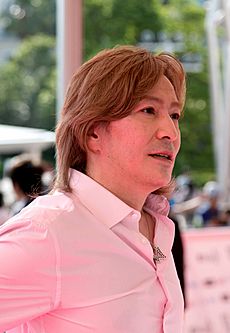Namie Amuro facts for kids
Quick facts for kids
Namie Amuro
|
|
|---|---|
| 安室 奈美恵 | |

Amuro at her 25th anniversary concert in Okinawa in September 2017
|
|
| Born | September 20, 1977 |
| Other names | Namie Maruyama (legally, 1997–2002) |
| Occupation |
|
| Years active | 1992–2018 |
|
Works
|
Discography |
| Spouse(s) |
Masaharu "Sam" Maruyama
(m. 1997; div. 2002) |
| Children | 1 |
| Musical career | |
| Genres | |
| Instruments | Vocals |
| Labels |
|
Namie Amuro (born September 20, 1977) is a retired Japanese singer who became a pop music icon in Japan and across Asia. She started as a teen idol and grew into a major star known for her amazing dancing, changing music styles, and cool fashion.
Often called the "Queen of Japanese Pop," her long and successful career is compared to Western stars like Janet Jackson and Madonna. Amuro was famous for always trying new things with her music and look, which kept her popular for over 25 years.
Born in Naha, Okinawa, Amuro began her career at age 14 in the group Super Monkey's. She went solo in 1995 and quickly became a huge star with hit songs like "Chase the Chance" and "Don't Wanna Cry". Her 1997 song "Can You Celebrate?" is still the best-selling single by a solo female artist in Japanese history.
Over the years, she explored different music genres, from pop to R&B and EDM. She sold millions of albums, including Sweet 19 Blues and Best Fiction. Amuro is the only artist in Japan to have a million-selling album in her teens, 20s, 30s, and 40s.
After a final tour and a greatest hits album called Finally, she retired from music on September 16, 2018. Having sold over 40 million records, she is one of the best-selling music artists in Japan.
Contents
Life and Career
1977–1995: A Star from Okinawa
Namie Amuro was born on September 20, 1977, in Naha, Okinawa. Her mother, Emiko Taira, raised her and her three siblings on her own. As a child, Amuro didn't dream of being a singer. But at age 12, she was discovered by Masayuki Makino, the owner of the Okinawa Actors School.
She joined the school and was soon placed in an idol group called Super Monkey's. In 1992, when Amuro was 14, the group released their first single. They didn't become famous right away, and the members moved to Tokyo to keep trying.
By 1994, Amuro was becoming more popular than the rest of the group. They changed their name to "Namie Amuro with Super Monkey's." Their 1995 single "Try Me (Watashi o Shinjite)" was a big hit. Soon after, Amuro left the group to start her solo career with the record label Avex Trax.
Working with the famous producer Tetsuya Komuro, Amuro released her first solo single, "Body Feels Exit". Her next single, "Chase the Chance", was her first number-one hit and sold over a million copies.
1996–1998: The Queen of J-Pop

In 1996, Amuro's fame exploded. Her singles "Don't Wanna Cry" and "You're My Sunshine" both sold over a million copies. Her first solo album, Sweet 19 Blues, sold over 3.6 million copies and made her a superstar.
Her fashion style—with long boots, miniskirts, and dyed brown hair—was copied by millions of young women in Japan. This trend was called "Amuraa."
In 1997, she released "Can You Celebrate?". It became the best-selling single by a solo female artist in Japanese history, selling over 2.7 million copies. Later that year, she released her second album, Concentration 20, which also sold nearly 2 million copies.
At a press conference in October 1997, Amuro announced she was marrying Masaharu "Sam" Maruyama from the band TRF and was pregnant. She took a one-year break from music to focus on her new family. In May 1998, she gave birth to her son, Haruto.
1999–2004: New Challenges and a New Style
Amuro returned to music in late 1998. In 1999, while she was promoting a new single, she faced a tragic family event with the sudden loss of her mother. She took a short break from work to be with her family.
She released the album Genius 2000 in 2000, working with American producer Dallas Austin. This album had more of a hip-hop and R&B sound. Her sales began to slow down as new artists like Hikaru Utada and Ayumi Hamasaki became popular.
In 2002, Amuro and her husband separated. She also began to take more creative control over her music. She was part of a project called Suite Chic, where she worked with other R&B and hip-hop artists.
Her 2003 album, Style, showed her new R&B direction. Though it sold less than her earlier albums, it marked an important change in her career. She was moving away from being a pop idol and becoming a mature artist.
2005–2009: A Triumphant Comeback

Amuro's hard work paid off. Her 2005 album, Queen of Hip-Pop, was a success. It blended hip-hop and pop, and the media began calling her by this new title. She also started touring across Asia, growing her fanbase outside of Japan.
In 2007, her album Play hit number one on the charts, her first in over seven years. The single "Baby Don't Cry" was a huge hit, proving she was back on top.
Her 2008 greatest hits album, Best Fiction, was a massive success. It sold over a million copies and stayed at number one for six weeks in a row. This made her the first Japanese artist to have a million-selling album in their teens, 20s, and 30s.
She followed this with the album Past<Future in 2009, which also went to number one. Amuro had successfully reinvented herself and was more popular than ever.
2010–2018: Global Music and Grand Finale
In the 2010s, Amuro continued to experiment with her sound. She explored EDM and began recording more songs in English. Her 2012 album Uncontrolled was a hit and featured the popular song "Love Story."
To celebrate her 20th anniversary in the music industry, she planned a huge concert in her hometown of Okinawa. Sadly, it was canceled because of a typhoon. However, she made up for it with a major tour of Japan's biggest stadiums.
She founded her own management company, Stella88, and a record label, Dimension Point. This gave her complete control over her career. She released more successful albums like Feel (2013) and Genic (2015).
On her 40th birthday, September 20, 2017, Amuro made a shocking announcement: she would retire from music in one year.
Her final album, Finally, was released in November 2017. It was a collection of her greatest hits from 1992 to 2017, with many songs re-recorded. The album sold over 2 million copies.
She said goodbye to her fans with a final tour across Japan and Asia. Her last public performance was on September 15, 2018, in Okinawa. The next day, September 16, 2018, she officially retired.
Legacy and Influence

Namie Amuro is one of the most important artists in Japanese music history. She changed the image of a J-pop idol from cute to cool and independent.
Her fashion in the 1990s started a nationwide trend called "Amuraa," where young women copied her style. She became a fashion icon and a role model for a generation.
Musically, she was known for always changing and taking risks. She brought R&B and hip-hop sounds into the J-pop mainstream. Her powerful dance performances and high-quality music videos set a new standard for artists in Japan.
With over 40 million records sold, she is one of Japan's best-selling artists. Her retirement was seen as the end of an era in Japanese pop music.
Discography
- Dance Tracks Vol. 1 (1995)
- Sweet 19 Blues (1996)
- Concentration 20 (1997)
- Genius 2000 (2000)
- Break The Rules (2000)
- Style (2003)
- Queen of Hip-Pop (2005)
- Play (2007)
- Past<Future (2009)
- Uncontrolled (2012)
- Feel (2013)
- Genic (2015)
Images for kids
-
Komuro and Amuro presenting the single "Never End" to Prime Minister Yoshiro Mori in 2000.
-
A billboard in Shibuya promoting Amuro's album Feel in 2013.
-
Amuro at her 25th anniversary concert in Okinawa in September 2017.
Awards
Video games
- Digital Dance Mix Vol. 1 Namie Amuro (1997, Sega Saturn)
See also
 In Spanish: Namie Amuro para niños
In Spanish: Namie Amuro para niños
- J-pop
- Japanese popular culture
- Honorific nicknames in popular music
- List of best-selling music artists in Japan
- List of best-selling singles in Japan
- List of best-selling albums in Japan
- Japan Record Awards
- MTV Video Music Awards Japan
- Billboard Japan Music Awards








